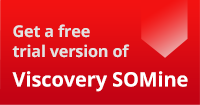データマイニングのトレンドとテクノロジー
Data visualization of asymmetric data using Sammon mapping and applications of self-organizing maps
Li (2005) Digital Repository at the University of Maryland, 17-Mar-2005
The performance of several software implementations of methods based on self-organizing maps was evaluated. Viscovery SOMine was found to be helpful in determining the number of clusters and recovering the cluster structure of data sets. A genocide and politicide data set was analyzed using Viscovery SOMine, followed by another analysis using public and private college data sets with the goal to identify schools with best values.
Interactive visual interfaces: A survey
Murtagh, Taskaya, Contreras, Mothe and Englmeier (2003) Artificial Intelligence Review 19:263-283
A contemporary implementation was reported, taking concept hierarchies as input data. The visual user interfaces expressed domain ontologies which were based on these concept hierarchies. A web-based implementation was detailed, and examples of usage were shown. Viscovery SOMine was one of the surveyed systems.
Comparative Analysis of the Graphical Result Presentation in the SOM Software
Dzemyda and Kurasova (2002) Informatica 13(3):275-286
Several software tools based on self-organizing maps are analyzed, using data on coastal dunes and their vegetation in Finland. The focus of the experimental comparison is the graphical result presentation. Viscovery SOMine was reviewed in comparison to SOM-PAK, SOM-TOOLBOX and Nenet as well as two academic systems.
Features, objects, and other things: ontological distinctions in the geographic domain
Mark, Skupin, and Smith (2001) in "Spatial Information Theory: Foundations of Geographic Information Science, Proceedings of COSIT 2001", ed. Daniel Montello (Springer) 488-502
Response were analyzed from 263 subjects giving examples for one of five geographic categories: geographic features, geographic objects, geographic concepts, something geographic, and something that could be portrayed on a map. The frequencies of various responses were significantly different, indicating that the basic ontological terms feature, object, etc., are not interchangeable but carry different meanings when combined with adjectives indicating geographic or mappable aspects. Viscovery SOMine was used for training and initial labeling of neurons, and ArcView for processing of base map configurations and two-dimensional interpolation.
A comparison of SOM neural networks and K-means clustering using real world data: Chinese consumer attitudes towards imported fruit
Sun, Collins, and Kim (2001) SHS Acta Horticulturae 566: II International Symposium on Application of Modelling as an Innovative Technology in the Agri-Food Chain; MODEL-IT
Self-organizing map neural networks were compared with K-means algorithms to test their relative ability to generate reliable clustering solutions using real world data: Chinese consumer attitudes towards imported fruit. Results show that K-means performs better than self-organizing maps in terms of reliability, but the strength of self-organizing maps is the ability to discover the “natural” number of clusters.
Data mining industry: emerging trends and new opportunities
Aldana (2000) Master of Engineering in Electrical Engineering and Computer Science at the Massachusetts Institute of Technology
Viscovery SOMine is reviewed.
A DACS State-of-the-Art Report - Mining Software Engineering Data: A Survey
Mendonca and Sunderhaft (1999), Report No. DACS-SOAR-99-3, University of Maryland
State-of-the-art as well as recent advances in the use of data mining techniques as applied to software process and product information was discussed. Also included are a discussion of data mining techniques and on how they can be used to analyze software engineering data, a bibliography on data mining with special emphasis on data mining of software engineering information, a survey of the data mining tools that are available to software engineering practitioners (including Viscovery SOMine) and a listing of web resources for data mining information.


